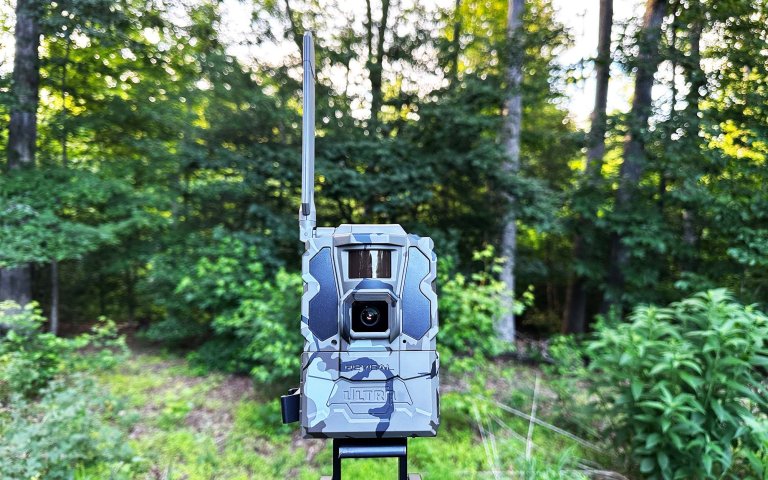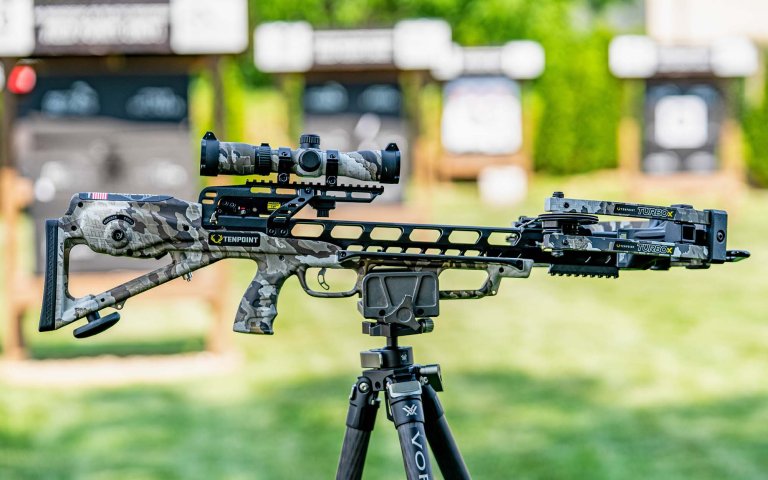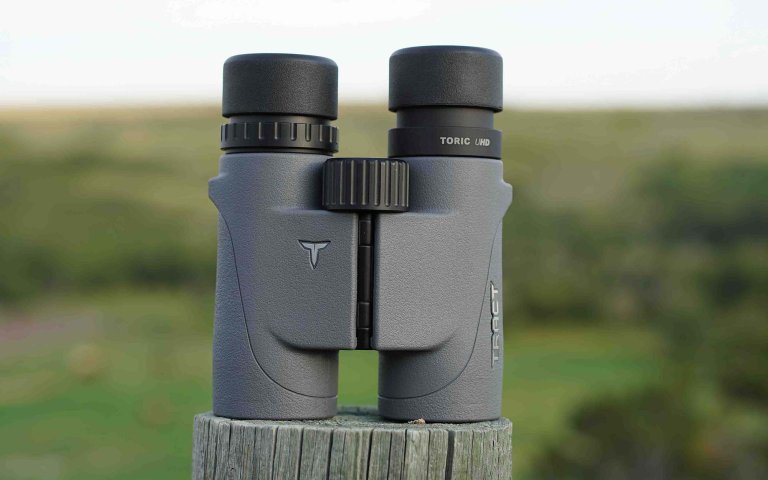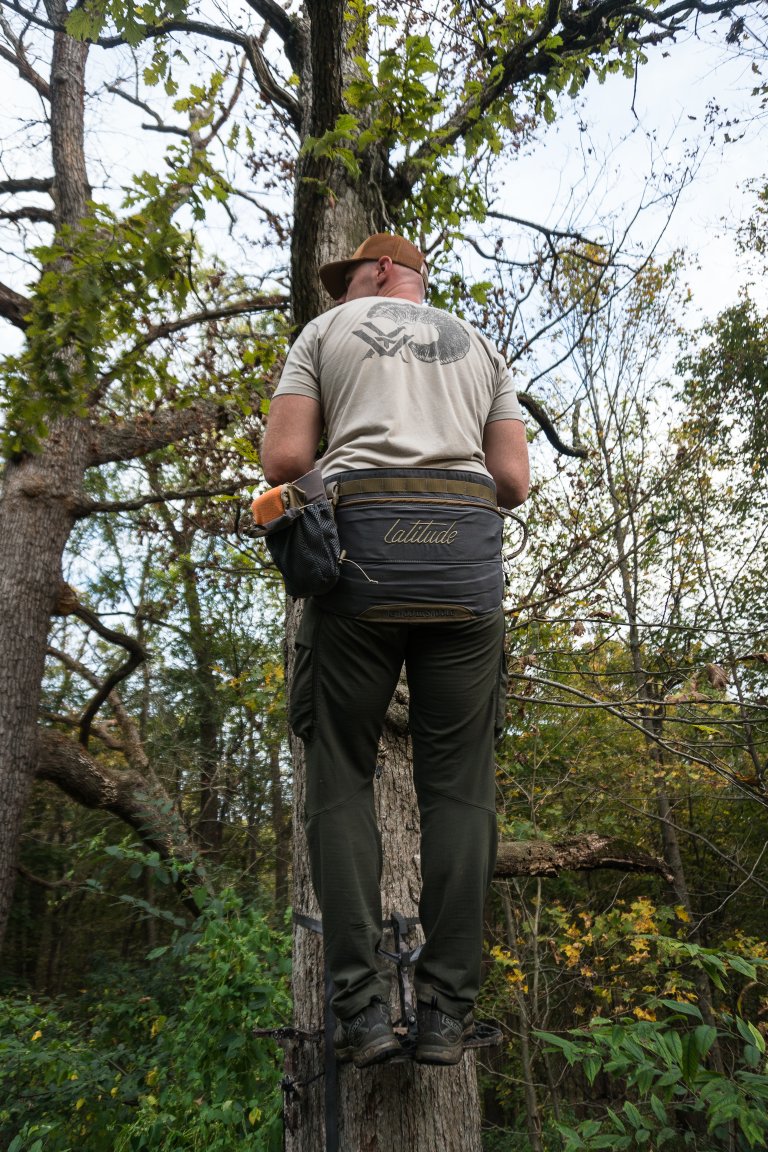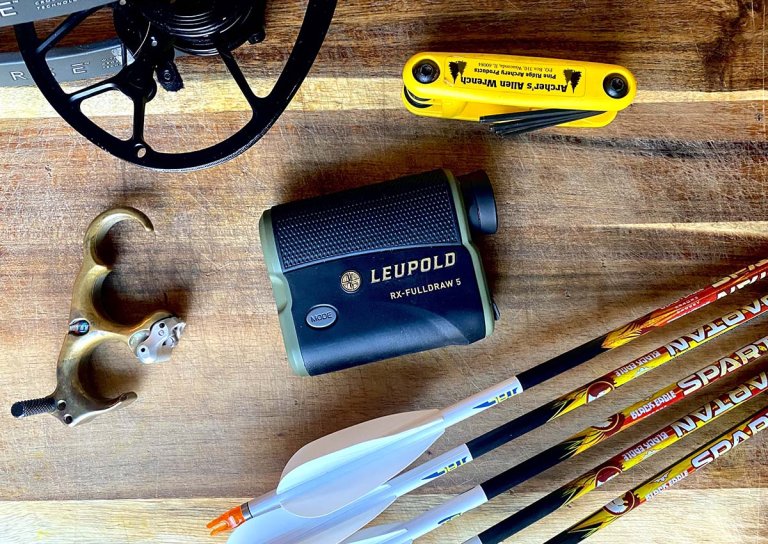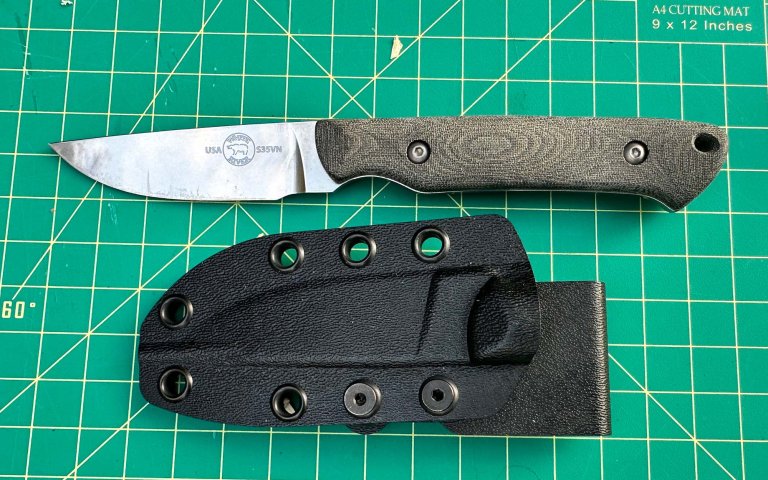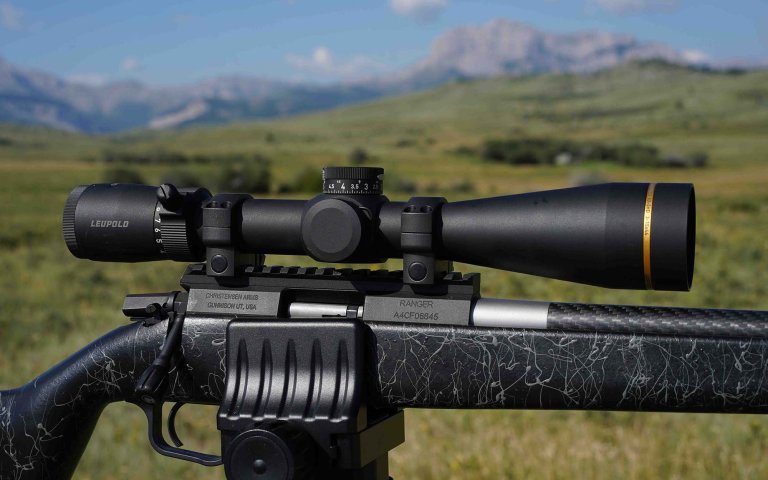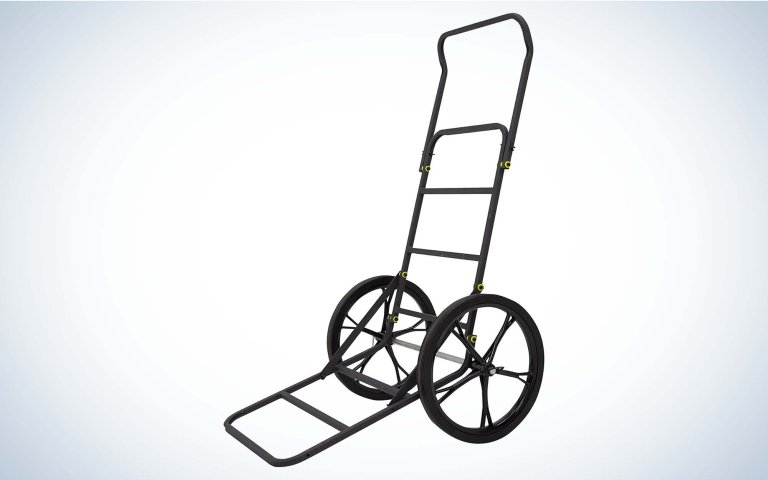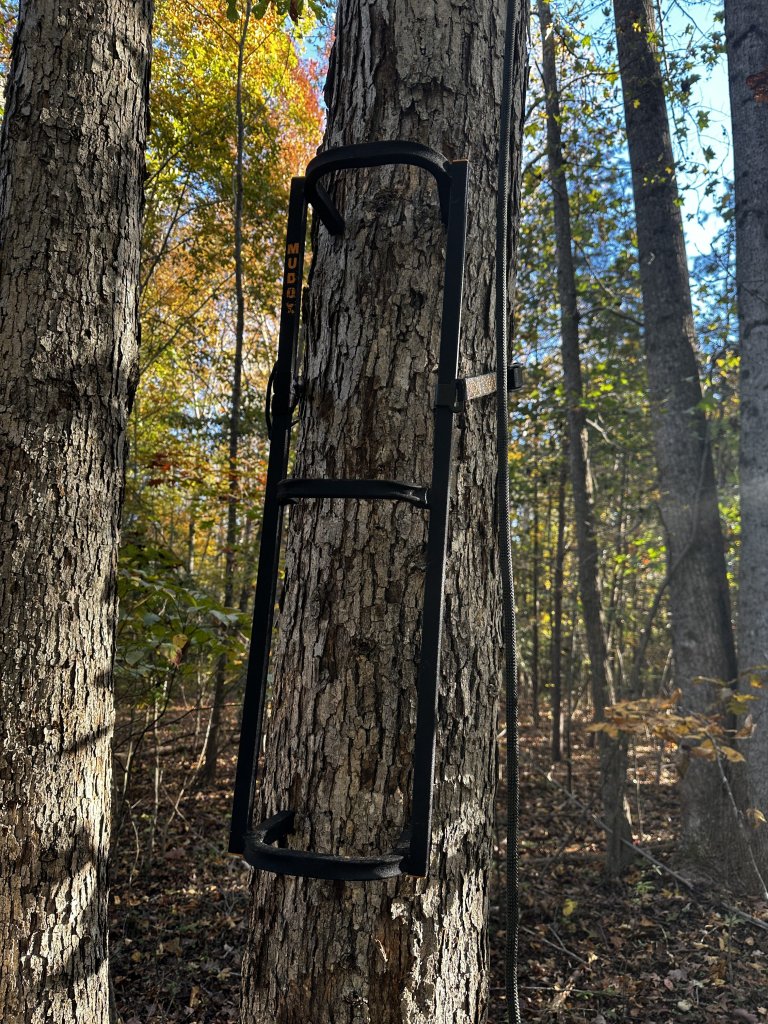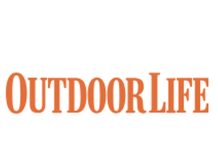One way to find out what deer hunting gear works, and what doesn’t, is to play equipment roulette. Or you could use the head-to-head tests we conducted this year to find your next treestand, trail camera, broadhead, rifle, or binocular. These reviews are a starting point for making educated purchases and reduce the chances of grabbing a lemon off the shelf. Here are our picks for the year’s best deer hunting gear based on exhaustive testing.
- Trail Camera: Tactacam Reveal Ultra
- Crossbow: TenPoint Turbo X
- Binocular: Tract Toric UHD 8×32
- Rangefinder for Bowhunting: Leupold RX-FullDraw 5
- Two-Panel Tree Saddle: Latitude Method 3
- Mechanical Broadhead: G5 Deadmeat V2
- Knife: White River Knives Small Game Hunter
- Arrow: Easton 5.0
- Best Scope: Leupold VX-5HD Gen 2 3-15×44
- Deer Cart: River’s Edge Game Cart
- Budget Climbing Sticks: Muddy Stagger-Steps Packable Ladder System
How We Chose the Best Deer Hunting Gear
Outdoor Life editors and contributors take our gear testing as seriously as our deer hunting. We’ve put each of the products we’re recommending through rigorous testing. It starts with amassing a bunch of products in one location and then putting them through a consistent test methodology. Once all the scores are added up and groups measured, the top performers are clear. So when we say something is the best, we’re confident it’s a great piece of gear.
Best Deer Hunting Gear: Reviews and Recommendations
Trail Camera: Tactacam Reveal Ultra
Pros
- Reliable
- Excellent customer service
- Good photo detail
- Customizable flash settings
- No SD card required
- Innovative accessories available
Cons
- Live is slow to turn on
- Not the best for video
Key Features
-
Price: $200 -
Cell Network LTE -
Up to 4K photo definition -
Flash Range: Up to 96 feet -
Low-glow or no-glow flash settings -
16 gb of internal storage -
SD card slot for optional additional storage -
Powered by 12 AA batteries -
Live video -
On-demand photos -
GPS
For the third year in a row Tactacam is our editor’s choice winner. The new Reveal Ultra has everything we like about last year’s winner, the Pro 3.0, and adds on features that serious trail camera users will appreciate. It has GPS, low and no-glow flash, and live video streaming. It maintains the 3.0’s fast camera speed, good battery life, and easy-to-use app.
The Reveal Ultra can toggle between low-glow or no-glow flash. Low-glow flash means there is a visible red light that comes on when the camera is triggered. The low-glow flash is brighter and illuminates a larger area than a no-glow flash. A no-glow flash emits no visible light and is a completely stealth option. It doesn’t light up a huge area and is best for photos where the subject is less than 60 feet away — scrapes and trails. No-glow is also a great option if you’re using a trail camera for security rather than hunting.
If you need to find your trail camera you can activate its GPS, which gives you a location update every 6 hours. The GPS function works even if the battery is dead or removed for up to 72 hours. That means if you lost your cameras, it gets stolen, or is moved by someone, you’ll be able to recover it.
During the walkthrough test, the Reveal Ultra triggered 100 percent of the time at 10 and 60 feet, but failed to trigger at night at 110 feet. That is above average performance based on past trail camera tests. Between the dozens of Tactacams we have in the field, we routinely see photos of deer captured at 60 feet and beyond.
The photo quality is excellent both day and night. Subjects are captured as they enter the frame or directly in the center. The images are crisp with no motion blur. The low-glow flash is impressive and it illuminates well beyond 110 feet without over exposing objects up close.
One thing I like about Tactacam is their plans are straight forward and fairly affordable. Here’s a breakdown of the different plans they offer.
| Plan | Price Per Month | Max Photos | Price for Adding an Additional Camera |
| Starter Plan | $5 | 250 | $5 |
| Intermediate Plan | $8 | 500 | $7.50 |
| Pro Plan | $13 | Unlimited | $12 |
You can pause your plan and restart it at any time, which is a convenient feature. It’s also important to note that if you want to get on-demand photos, download HD photos, or enable live videos you have to get the Xtra plan, which is an additional $9 and covers all your cameras.
There are a few downsides to the Ultra. In video mode, you can’t view videos right away. The app displays a thumbnail and you’ll need to request the video before viewing it. The live video mode is slower to start up than my Spartan GoLive2. The Reveal app doesn’t have a species filter which can make sorting through photos time consuming. It does have filters for custom tags, weather, date, and time.
I currently have three Tactacams on my lease and 30 more on an out of state property. Alex Robinson, OL’s editor-in-chief and one of the authors of this article, also runs several Tactacams. That’s a large sample size and we’ve yet to encounter a significant issue. I got to test the Ultra before it was released to the public and on the launch date, it started glitching. I used Tactacam’s US-based support line to trouble shoot the issue and quickly spoke to a real human. The customer service representative helped me resolve the issue and I was back in business.
In our experience, you’re not likely to have an issue with a Tactacam, and if you do, they have excellent customer service to help you out. — Scott Einsmann
Recommended Accessories
Crossbow: TenPoint Turbo X
Pros
- Well balanced
- Easy to cock and de-cock
- Good ergonomics
Cons
- Not compact
- Not very fast
Key Features
-
Length:
33.25 inches -
Width Uncocked:
13 inches -
Weight:
6.8 pounds -
Price:
$1,350
Test Results
-
Accuracy:
1.23 inches -
Trigger Pull Weight:
2 pounds -
Speed:
415 fps (410-grain arrow)
The TenPoint Turbo X was the most accurate crossbow we tested this year. It’s also $870 cheaper than the second most accurate crossbow and $1,200 less than the fastest crossbow. It was one of the easiest to cock and decock and it shot very well in all field positions. When you add up those factors and our score sheets, we couldn’t deny the Turbo X as the 2025 editor’s choice winner.
Turbo X shot a 1.23-inch group average out of four, three-shot groups at 50 yards. While the bench shooting was impressive, the crossbow was far from done showing off. Horner shot the crossbow off-hand extensively and printed several 3-inch groups at 50. He also stretched it out to 85 yards off-hand, and his group was under 8 inches.
Over the years of testing crossbows, I’ve learned that some are sensitive to shooter input. For example, if you pull the stock tightly into your shoulder on one shot and use a relaxed grip on the next, the arrows hit in different places. The Turbo X maintained the same point of impact for two shooters on the bench, offhand, and off a tripod.
What about broadheads? We tested that too. At 40 yards, a G5 DeadMeat hit perfectly with the field point. A Muzzy Trocar Crossbow Broadhead, hit about 3-inches low. We also shot a TenPoint Evo-X as well, and it landed more than 8 inches from the field point’s impact point. We were hoping the Turbo X would shoot any fixed blade given its relatively low speed and high-accuracy potential. But if you’re planning on shooting fixed heads, we recommend trying a few different designs to see what flies best.
The Turbo X uses TenPoint’s ACUslide cocking mechanism, it’s also used on the $2,650 Flatline 460. It’s a very easy system to use. You can go from unloaded to ready to fire in under 30 seconds. We think the cocking effort is low enough that a young hunter can crank it back on their own.
The Turbo X isn’t the fastest crossbow by any means. We chronographed it at 415 fps with a 400-grain arrow and measured its drop from 20 to 40 yards at 6.5 inches. So while it’s about 100 fps slower than the TenPoint TRX 515, it will still give you plenty of forgiveness in range estimation. One benefit of a slower crossbow is that the strings don’t wear out as quickly as their higher fps counterparts.
The main disadvantage of the Turbo X is that it’s a long crossbow. It won’t be easy to maneuver in a ground blind or through thick brush. Another con is the scope rail isn’t made of metal like we see on more expensive crossbows.— Scott Einsmann
Binocular: Tract Toric UHD 8×32
Pros
- Tight and durable build
- Bright Schott high-transmission glass
- Light at 23 ounces
- Easy one-hand operation
- Tight and positive controls
- Lifetime warranty
Cons
- Relatively expensive for a compact bino
- Slight blue edge aberration
Key Features
-
Closed-bridge design Locking right-barrel diopter -
Front-hinge ¼-20 tripod thread -
Magnesium-alloy chassis -
3-position eyecups -
Easy one-hand operation
Calm down, settlers. I hear your roars of discontent that we have named a $644 compact binocular an Outdoor Life Great Buy. That’s a lot of money for relatively little glass. But hear me out. First, there wasn’t a lot of competition for the award this year. There were cheaper submissions, but they were optically inferior to this bright, tight little unit. And this binocular from a direct-to-consumer company punches way above its size. Add the lifetime warranty and versatility from whitetail stands to turkey vests to every truck console in America, and this is the binocular you will reach for above all others.
We’ve tested the big brothers of the 8×32 in previous tests, but this configuration hits a sweet spot. Its image seems like it was delivered by a big 10×42, but the small frame of the 8×32 fits in places the larger chassis doesn’t.
Then there’s the tight build of the Toric. Those who have followed the evolution of Tract Optics know one of its distinctive features is smooth, positive, extremely tactile controls. Scope turrets move with smooth precision and binocular eyecups feel like they glide on ball-bearing races. Those controls extend to the focus wheel, locking diopter control, and eyecups of this smallish binocular.
The detail that cemented the Great Buy award for the Tract Toric is its lifetime warranty. I doubt you’d ever use that coverage, but it’s useful to know that you have a binocular for life. In the field, you’ll use it for a one-handed spot-and-stalk bowhunting optic. You’ll have it in your bino pouch for turkey hunting or hiking. Or you’ll throw it in your luggage for a travel optic.
Testers subtracted points for a fairly clunky build and some blue color fringing. Testers who gravitate toward full-sized 10×42 binos thought the compact Tract was underwhelming.
“My first impression was that I didn’t want to like this binocular,” noted tester Ky Idler. “But surprisingly it fit my hands. Good glass. It would be a very good spot-and-stalk binocular.”
The Tract seems bigger than it is largely because of its excellent glass. It’s built around high-transmission Schott glass, manufactured in Japan, and has a wide field of view. Normally, I like open-barrel designs for one-hand operation, but the closed-bridge build of the Toric, while a little center-weighted, has enough heft that it settles in hand, whether one hand or two.
I’d readily use this binocular for bowhunting, when single-hand operation is required and where positive focus control helps parse close, medium, and far range targets. The Tract capably handles this chore with aplomb, if not distinctive style.
Maybe this helps answer the question: Is $644 too much to pay for a quality compact binocular? In the case of the Tract Toric UHD, the answer is decidedly no. While I’m not eager to pay more, this is a solid deal for a very good and versatile hunting optic. — Andrew McKean
Two-Panel Saddle: Latitude Method 3
Pros
- Magnetic panel management system is easy to use and secures panels in place
- Comfortable
- Metal-free design makes it incredibly quiet
- Affordable
Cons
- Heaviest saddle in the test
- Material can get warm if worn during transport, especially during early seasons
Key Features
-
Weight: 2 pounds 7 ounces -
MOLLE webbing: 1 row on waist belt (top panel) -
Waist belt: prusik knot -
Leg straps: removable webbing strap with G-hook -
Bridge type: Latitude’s proprietary rope-style “Butter Bridge” -
Special features: metal-free construction, magnetic Quick-Connect System attaches panels while on the move -
Comfort: 5 -
Price: $299.99
The Method 3 is Latitude’s latest addition to their saddle lineup. Similar to the Method 2, the Method 3 uses thoughtfully placed magnets to create a saddle that functions as a single- or two-panel, depending on your preference. Unlike the Method 2 that used several small magnets that needed to be aligned for optimal functionality, the Method 3 has a continuous strip built into the panels to eliminate the hassle of aligning magnets. The panels effortlessly pop in and out of place, and I was especially impressed by how they stay together while walking. I never experienced the panels coming apart in transport.
The Method 3 uses a drawstring system to tailor the saddle’s fit when being used as a two-panel. Simply deploy the bottom panel and use the drawstring stoppers to dial in the fitment. The slack material in the drawstring stoppers also function as an ultralight, built-in stick hauler to loop over climbing sticks.
If you’re looking for comfort, the Method 3 delivers. Integrated water-resistant padding on both panels is a plush feature that makes it superior to all saddles in the test for all-day comfort. As is usually the case, comfort comes at a slight weight penalty. At 2 pounds 7 ounces, it’s heavy. My Method 3 weighed in at 4 pounds 1 ounce once fully set up with dump pouches and ropes.
I added Latitude’s brand-new Operator Pouch to my Method 3, which I think is the best accessory on the market. The Operator Pouch is easy to operate with one hand and maintains its structure when empty, which makes it easy to stow gear away in low light. A fleece liner makes for silent operation, and quick-detach design uses buckles to remove it from your saddle to maintain a sleek profile while hunting.
At $299, the Method 3 is the best value in the test. I was impressed by the value of the Method 2 one year ago (which also retailed for $299). Given the upgraded features, functionality, and materials in the Method 3, I’m pleasantly surprised Latitude didn’t raise prices despite packing even more value into a top-notch product. — Erik Barber
Rangefinder for Bowhunting: Leupold RX-FullDraw 5
Pros
- Selectable reticles
- Customizable arrow dynamic inputs
- Compatible with low-velocity arrows
- 6- to 1,200-yard range
Cons
- No tripod mount
- Ballistics input process is tedious
Key Features
-
6x22mm monocular -
Customizable arrow ballistics -
Flightpath technology -
Archer’s Advantage
The most precise archery-specific rangefinder on the market, the new RX-FullDraw 5 builds on the attributes of the FullDraw 4, which introduced integrated Archer’s Advantage software that allows bowhunters to shoot a range and then compensate for limbs and other obstacles that might impede their arrow. It also removes the need for a cut chart when shooting extreme angles. The angle compensation makes this a must-have rangefinder for anyone hunting sheep, mule deer, or aoudad in the cliffs. It’s also a great piece of deer hunting gear for treestand hunters.
The FullDraw 5 has a 20-yard pin solution that improves the Flightpath technology, a rain/fog mode that enables close shots, Leupold’s excellent DNA ranging engine, and new ranging software that accounts for lower arrow velocities, a feature that will appeal to traditional archers or compounders trying heavy arrows.—Andrew McKean
Read our full review of the FullDraw 5 to learn more.
Knife: White River Knives Small Game Hunter
Pros
- Sculpted handle
- Excellent for slicing and piercing
- Works well for small and big game
Cons
- Some hunters might want a slightly longer blade
Key Features
-
Blade Steel:
S35VN (58-60 HRC) or MagnaCut (62-64 HRC) -
Handle Materials:
Micarta -
Overall Length:
7.25 inches -
Blade Length:
2.62 inches -
Blade Thickness:
.130 inch -
Grind:
Flat -
Kydex Sheath -
Made in USA -
Price:
$160 (S35VN) or $180 (MagnaCut)

I have five things that I look for in a great hunting knife and of all the knives I tested, this is the one that ticks all those boxes. Its blade shape is perfect for field dressing, deboning, and caping. The knife is small enough to be easy to pack, but it has all the capability you need to process an animal in the field. The grind is slicey, which made it one of the top performers in my cut test. S35VN is a great steel because it has excellent corrosion resistance and strikes a nice balance of edge retention and toughness. The big handle allows a full grip and its coke-bottle shape makes for comfortable ergonomics. Its sculpted grip conforms to your hand with a hammer grip, thumb on the spine, or index finger on the spine. I like the ledge at the front of the handle, which is the perfect spot to place your thumb when using an index-finger-on-the-spine grip.
While this knife is called the Small Game Hunter, it by no means is limited to squirrels and rabbits. The 2.6-inch blade is all I need for field dressing and quartering a deer. This year, I lent it to a professional deer butcher who cuts up hundreds of animals per year, and he was impressed with this knife’s cutting ability and ergonomics. If you like the overall design, but want a larger blade I recommend looking at the 3.5-inch White River Hunter. — Scott Einsmann
Mechanical Broadhead: G5 Deadmeat V2
Pros
- One of the largest wound channels
- One of the sharpest out of the package
- Comes with practice head
Cons
- Some users report premature blade deployment
Test Results
-
Sharp Out of the Box:
Yes -
Passed Edge Retention:
Yes -
Passed Durability Test:
Yes -
Push Force:
149.45 pounds -
Measured Wound Channel:
2.04 inches -
40-Yard Group Average:
2 inches
The Deadmeat V2 is a rear-deploying mechanical, available in 100 or 125 grains. The blades are retained by a collar rather than a band. Snyder cautions that the blades can deploy when caught on brush during a stalk, which is less of an issue for treestand hunters.
In the gel test, there were only a few broadheads that recorded a wound channel over two inches, and the Deadmeat V2 was one of them. “The Deadmeat is one of the most accurate and devastating mechanicals I’ve used,” Snyder said. Our testing confirmed his in-the-field experience. Aside from the large wound channel, the Deadmeat V2 was accurate, durable, and at 220 grams it was the third sharpest. It also did the second best of all the mechanicals in the push force test, despite its large cutting diameter. The blade sharpness and tip design were contributors to its ease of penetration. — Scott Einsmann
Arrow: Easton 5.0
Buy From Lancaster Archery Supply
Pros
- Ultralight
- Micro-diameter
- Unmatched consistency
- Has compatible components that allow for building lightweight, fast arrows, or high-FOC bone crunchers
Cons
- Not the very best option for shooting long distances
Key Features
-
.001 and .003 straightness versions -
Spines:
200, 250, 300, 340, 400, and 500 -
Compenents:
Halfouts or HIT inserts -
Made in USA -
Inside Diameter:
.204 inch -
Weight (340 spine):
7.4 grains per inch -
Price (.003):
$110 (6 fletched arrows), $170 (dozen shafts)
Easton finally built the ultimate arrow when they came out with the 5.0 late last year. Due to incredible demand, bowhunters are just starting to get them in their hands now.
The 5.0 is more than just an arrow – it’s an arrow system because you can build it the way you want. To start, it’s a 5mm arrow built using Easton’s Acu-Carbon process, which was made famous by the Axis series of arrows. Instead of rolling the carbon around a mandril to form the shaft, Easton weaves the carbon over the mandril in a continuous process.
This construction minimizes the effect of a “high spine,” which is a line of stiffer carbon running the length of the arrow commonly found when the carbon is rolled. Ideally, you want to identify that high spine and make sure it’s facing up when you load the arrow to shoot. Because of the 5.0’s construction, that orientation is less critical than it is with other shafts. Also, the continuous weave means the first arrow off the line will match the 387,000th arrow off the line, and every one in between. Buy a dozen this year, and the weights and straightness tolerances will match the dozen you buy three years from now.
Where Easton hit the 5.0 out of the park is in making the shaft super light. The 300-spine 5.0 weighs 8.4 grains per inch. That’s not the lightest arrow on the market, but it’s pretty light. So if you’re looking for a flat-shooting arrow, you can build the 5.0 to be super light. Put in the aluminum HIT inserts and some 2.5-inch fletchings, and you’ve got a real speed burner.
Easton has a series of components made for the 5.0 that allow you to add weight to the front to make the arrow hit like a sledgehammer while maintaining long-range accuracy. You can build a 5.0 arrow with 15 percent FOC that’s still a viable, long-range arrow, as opposed to one that weighs 700 grains.
Easton has a series of components that allow you to build the 5.0 arrow you want. There are inserts that weigh 16 grains, 25 grains, 50 grains, and 75 grains. You decide how much weight you want in the front of your arrow to get the performance you’re looking for.
Along with that, Easton offers the 5.0 in 200, 250, 300, 340, 400 and 500 spines. The varied spine offerings are critical for building high-FOC arrows that will still fly well. One of the common mistakes bowhunters make in building arrows with high FOC, is they don’t consider the effect that added weight has on the arrow spine.
The more weight you add to the front of an arrow, the weaker the spine gets. So a hunter shooting a 70-pound draw weight with a 29-inch arrow would want that arrow to be 300 spine with a 100-grain point. If the hunter adds 50-100 grains to the front of that arrow, the correct spine for solid arrow performance is going to change to 250 or even 200. But bowhunters don’t realize that, so they end up sticking with the now-weakened 300, which likely won’t always fly well – especially as the shooting distance increases. — P.J. Reilly
Best Scope: Leupold VX-5HD Gen 2 3-15×44
Pros
- At 20.1 ounces, very light
- SZL Speed Set elevation dial
- Excellent turret indexing
- Custom-dial system compatibility
- Hunting-centric magnification range
- Overbuilt and reliable erector system
Cons
- Custom turrets require specific inputs
- Duplex reticle limits versatility
Key Features
-
30mm tube -
Multiple illumination/reticle choices -
Side parallax from 50 yards to infinity -
Locking turrets minimize inadvertent movement -
Elegant push-button illumination -
Tool-less turret removal

On its surface, the Gen2 version of Leupold’s classic hunting scope, the VX-5HD, basically has cool tool-less turrets and some upgraded coatings. It’s what you can’t see in this scope that makes it one of the most reliable hunting scopes of the year and a worthy heir to Leupold’s original VX-3 line: honest hunting scopes in a bunch of configurations and reticle choices.
The Gen2 model was released last month, and follows the release of Gen2 turrets on the upgraded VX-6HD earlier in the year. Optically, there’s not a whole lot of updates. Leupold highlights its “Professional-Grade Optical System” which includes very good glass and coatings optimized to resist scratching and to temper glare, but you won’t see a major improvement on the very good Gen1 VX-5HD.
The new SpeedSet tool-less elevation dial is the most apparent upgrade in the Gen2 line. This is a cool and useful system. Just release a locking lever with your fingertips, lift up the closure, and the whole turret pulls off, simplifying re-zeroing in the field and making turret changes fast and easy. The value proposition of the system is with Leupold’s CDS custom dial system. Order a custom dial for different rifles or bullet weights and swap the turrets in seconds.
But what made the VX-5HD Gen2 the consensus pick for our Editor’s Choice award is what you can’t see. Leupold has invested heavily in its turret erector system, which includes the springs that keep the internal reticle tube aligned, the gears that move the erector tube with precision, and even the industrial lubricants that keep the whole works moving click after click and year after year. The guts of the VX-5HD Gen2 are very similar to those of Leupold’s Mark 5HD line, used for precision target shooting and military sniping.

From a users’ standpoint, the scope simply works. It has ample mounting dimensions along its 30mm tube to fit a wide range of receivers. Its controls turn easily but precisely. And its eyebox is forgiving, meaning that shooters don’t have to be perfectly aligned with the exit pupil to see the entire field of view.
The VX-5HD Gen2 line has one design element that holds it back from being an even better scope. The SpeedSet turret system is limited to two revolutions of elevation. That’s plenty for most hunting situations, yet not enough for long range target shooting beyond 1,000 yards. Because the elevation dial has only 38 MOA of travel, but the scope has 85 MOA of total internal adjustment, users aren’t able to utilize most of the adjustment range.
On the positive side, though, the system ensures the erector system stays in the middle of the adjustment range, which adds to overall accuracy and precision.

We also note fairly limited reticle choices in the second-plane system. Our test sample came with the versatile FireDot duplex. The VX-5HD Gen2 is also available in TMOA, FireDot Twilight Hunter, Wind-Plex, and HTMR-MIL reticles, most of which are variations on the traditional plex style.
These reticles limit holdover options, though once users get accustomed to dialing their drop, elevation references aren’t as important as they might be on a scope with standard turret demarcations.
We love the 8-step push-button illumination module, and the 50-yards-to-infinity side focus turns with smooth precision. Lastly, the VX-5HD Gen2 is among the lightest hunting scopes in our test, making it a boon companion to just about any mountain rifle. The redesigned scope is also durable enough for just about any hunting rig. At prices ranging from $1,500 to $2,000, depending on model, it’s a pricey scope. But as Mark Copenhaver, tester and notorious skinflint, noted, “If I was buying any of the scopes in this year’s test, this is the one I would buy.” — Andrew McKean
Deer Cart: River’s Edge Game Cart
Pros
- Quick and easy assembly, no tools needed
- Lightest-weight cart in the test
- Easy to maneuver
- Good ground clearance
- Wheels don’t require inflating
Cons
- Not foldable without disassembling
- Carrying capacity 200 pounds less than competitors
- Open spoke design may get sticks, branches caught in wheels
- Aluminum frame could get banged up over time
Key Features
-
Carrying capacity:
Up to 300 pounds -
Cart weight:
29 pounds -
Aluminum frame -
Overall dimensions:
56 x 20 inches -
Two 16-inch solid rubber tires (airless) -
Manufactured overseas, assembled in Wisconsin -
Price:
$130
This deer cart from River’s Edge was everything the other carts in this test weren’t: simple to assemble, lightweight (thanks to its aluminum frame), and low profile, with the most affordable price tag to boot. Wheeling this cart without a deer did not require effort, which cannot be said for the other heavier carts I reviewed; it weighs two thirds of the Hawk Crawler and half the Cabela’s Deluxe cart. The best deer carts should make hauling out your deer easier, not just as miserable in a different way. Sliding this cart into the back of my truck wasn’t difficult either.

Of course, you sacrifice a few features with this design, but those aren’t any great loss for my physical abilities or the way I hunt. The River’s Edge Game Cart frame is smaller than the similarly designed Cabela’s Deluxe Game Cart, but that also makes it easier to transport and maneuver. The size of the frame held a big Missouri doe just fine, although I would recommend bungee cords or small ratchet straps to secure your deer for longer hauls to prevent it from sliding off, particularly on steep terrain. The 300-pound maximum capacity doesn’t deter me, as I’ve never shot a Midwestern whitetail that weighed even close to that. (If you hunt in the North Woods or Saskatchewan and plan to shoot the next 400-pound buck, sure, go with a different cart.) The solid rubber wheels also mean one less failure point of a flat tire in the woods or when you finally need your cart three weeks into the season.
Although you can technically fold the River’s Edge cart for transportation and storage, it requires disassembly of everything but the axle and pins. There are holes in the frame for bolt storage during transport or the off season, but the odds of dropping wing nuts and losing them in the dark or duff are high. Most of the best deer carts are made in China and though this River’s Edge cart probably is too (a customer service representative told me its parent company, Ardisam, has multiple factories “overseas” but couldn’t specify which countries), it is designed and assembled in Wisconsin. If you hunt gnarly terrain, the high ground clearance of the 16-inch wheels may be a nuisance rather than a blessing and cause tipping when wheeled over bigger logs or the steepest inclines. Overall, though, I like the light and fast design of the River’s Edge deer cart best. — Natalie Krebs
Budget Climbing Sticks: Muddy Stagger-Steps Packable Ladder System
Pros
- $80 for three sticks
- Light and easy to set up
Cons
- Narrow steps

I didn’t mind spending $200+ on sticks when I only needed one set, but now that I’m a retired from my hang’n hunt days, I’ve come to appreciate how expensive it is to have multiple stand setups. These Muddy climbing sticks have been my go-to to keep costs down and they’ve performed great. They’re fairly light, are easy to attach and I haven’t had any issues while climbing. My only complaint is that the width of the steps is a little narrow when wearing rubber boots. — Scott Einsmann
The post The Deer Hunting Gear We Trust appeared first on Outdoor Life.
Whitecounty.com Appreciate the great content from Outdoor L:ife



